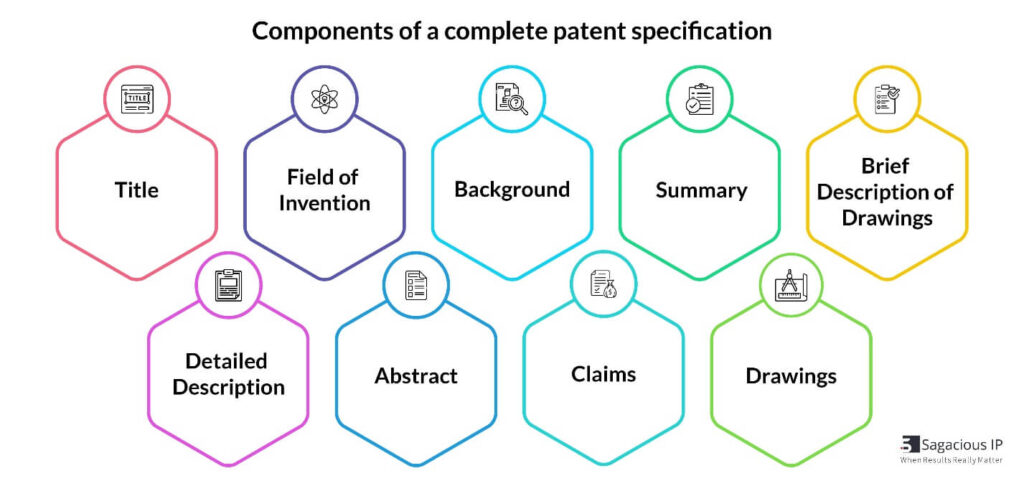Defining Common Terms in Patent Specification for a Foolproof Application
Using common terms in a patent specification with undefined or common meanings can create issues, such as confusion or broad/multiple interpretations during application examination. This can easily lead to a delay in approval or even rejection of the patent application. So, to avoid such risks, the applicant should use well-defined terminology in a patent specification and its elements, such as background, description, claims, drawings, etc.
This article discusses how using standard terms in a patent application can make the examiner develop broad interpretations, creating a problem for the applicant, and how one can avoid such ambiguities with simple measures, such as defining common terms in description and reciting embodiments in claims, to enhance the chances of approval.
Table of Contents
Understanding Patent Specification
In a patent application, the term “specification” relates to the written disclosure, which is not part of the claims or the abstract. Also known as the written description, it usually includes the manner and process of creating and using the invention in a complete, clear, and precise manner. As a best practice, the patent specification must describe at least one embodiment of the invention to enable its actual working. However, patent specification is not limited to describing the invention and its embodiments and has a much broader meaning. It facilitates comprehending claimed inventions and acts as a dictionary or glossary for patent claims.
An applicant can define the terms used in the claims to provide any specific meaning to a term. So technically, the patent specification should include the terms, concepts, and meanings that can be exported to the claims. As the claims typically involve definitions, the specifications must have placeholders with detailed meanings of the words and their intended purpose for using them in the claims. However, it must not contradict, such as including something under claims in an attempt to save the patent application although it is already specified in the patent specification.
Elements of Complete Patent Specification

Defining Terms in Specification
A description in a patent application may be clear, yet any words can be open to interpretation by the examiner. Under Patent Office rules, an examiner must take the broadest reasonable interpretation of a “person of ordinary skill in the art.” Therefore, the next question will be, “What is the broadest reasonable interpretation, how broad is it, and when does it become too broad?”
For interpreting claims, the examiner primarily relies on how the applicant has described the term in the specification. If a patent applicant leaves the term undefined, the examiner ordinarily uses a “plain meaning” of the term to implement the broadest reasonable interpretation.
It may become a problem for the applicant during prosecution or even after the patent grant, as the term or element can have multiple meanings. Often, simple words are left undefined and are open to many interpretations by the examiner. Let us delve into this with a recent case study.
A Case Study
There was a recent case in the Court of Appeals for the Federal Circuit, In Re: Smith Int’l, Inc. Appeal 2016-2303 (Fed. Cir., Sept. 16, 2017), wherein the term “body” used in an application for a mechanical device patent was in question. In the patent application, several claims were directed to a mechanical assembly, having one element, “body.” It was found in the patent specification, but unfortunately, the applicant did not explain it in a limiting way. As the understanding goes, “body” is an open-ended term and may be subject to many interpretations in the patent specification. So, while reexamining, the Patent Appeal Board determined that the term is generic, and the patent specification did not identify the structural specificity. As a result, the claims were disallowed.
On further appeal, the court reversed and noted that even though the patent specification and claims failed to elaborate its precise meaning, the term was not used generically in the patent specification, opposing the Patent Appeal Board’s conclusion. The court further noted that the term was described distinctly from other elements of the invention, suggesting that it had some uniqueness in its meaning – based on the figures in the application. The court said that under the broadest reasonable interpretation (BRI), the interpretation must conform to the described use. Here, the applicant had not acted as a lexicographer relative to “body,” but that reasoning alone was insufficient to read the term overly broad.
Understanding Reasonable Interpretation
Let us consider a case with a simple and reasonable explanation. If an Indian inventor innovates a process that executes at 34 degrees Celsius, the patent drafter might refer to this as “a process being carried out at a standard room temperature.” This is because the Indian standard room temperature is 34 degrees Celsius. But in other parts of the world, the standard room temperature might be a bit warmer or colder. Therefore, the “standard room temperature” is non-universal and does not have standard acceptability across all countries.
Thus, in situations where the meaning can vary or have ambiguity, the best practice is to define the exact meaning of that particular element. Therefore, an ideal way of describing this will be, “the process may be carried out between 28 degrees Celsius to 34 degrees Celsius, which is sometimes referred to as a standard room temperature in the description.” This can provide a clear understanding to the examiner of the operating conditions of the process and will not be subject to any unreasonable interpretation.
Conclusion
Avoiding reliance on plain and ordinary meaning when a specific meaning is attached to a term can go a long way in helping the examiner understand the invention and claim. In case the drafter does not define in the patent specification, the terms are given their ordinary meaning as would be understood by a person of skill in the relevant technology area. Therefore, as a best practice, one must ensure that embodiments that are intended to be protected are explicitly recited in the claims, and the terms explained in the descriptions. Even while changing terms between related applications, one should always look at the possible meanings in the new sections and their impact in the related cases.
We, at Sagacious IP, provide reliable patent drafting services wherein we create patent applications that not only fulfill the requirements of the patent office but also modify the ideas to ensure the broadest possible coverage, preventing it from being bypassed by a third party. Our subject matter experts work with the patent drafter to ensure that the patent application is technically sound and covers all possible variants. Visit the service page to know more.
– Yojit Bhugra (Engineering Drafting) and the Editorial Team




